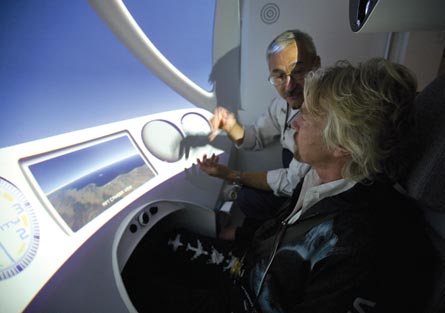Light this candle is a phrase that is being relaunched in the lexicon of a new generation of civilian space adventurers readying for the dawn of the large-scale space tourism industry.
While Alan Shepard happened to be sitting atop a Mercury Redstone rocket in 1961 when he spoke those words just before becoming the first American in suborbital space, the new breed of space explorer can get his or her candle lit on the ground in a suburb of Philadelphia long before heading into orbit.
As part of Environmental Tectonics's (ETC) two-year-old space launch training programme, aspiring space adventurers with about $6,000 can find out how it will feel to be launched into orbit and whether they will be suitable candidates for the rigours of suborbital flight, a wise idea before plunking down $200,000 or more for the kind of 5min weightlessness adventures being planned by the likes of Virgin Galactic. ETC's national aerospace training and research (Nastar) centre has trained 218 would-be space tourists and 12 researchers in certain aspects of suborbital flight with parameters similar to what Virgin Galactic is proposing for SpaceShipTwo.
|
|---|
In addition to an altitude chamber, the company has a variety of constant-motion simulator devices, including its STS-400 Phoenix centrifuge with single-seat cockpit representative of a generic seat in a suborbital space vehicle. The STS-400 can provide simultaneous gz forces (pushes the passenger into the seat bottom) and gx forces (pushes the passenger into the seat back) that simulate the rocket ignition and pitch-up manoeuvre of a suborbital rocket after drop from a captive-carry aircraft.
"This is the only facility in the world that can do the two-axis simulation of this effect," says Brienna Henwood, Nastar director of space research. "We have rapid onset rate ability to match the profile exactly."
The programme itself was born out of necessity for one of the original citizen space travellers six years ago. Greg Olsen, a New Jersey businessman, had tried to secure a $30 million seat on a Russian Soyuz launcher for a 10-day visit to the International Space Station through Virginia-based Space Adventures. For reasons that have not been disclosed, Olsen washed out during the qualification process in Russia in 2004.
Refusing to give up, he researched manufacturers of human-rated centrifuges and ended up at ETC in Philadelphia, says Henwood. He contracted ETC to create a Soyuz launch and re-entry profile on the centrifuge and began g-tolerance training on the device. Olsen was accepted the second time around and became the third space tourist to the ISS in October 2005.
Combined with the advent of commercial suborbital flight ventures, spawned in part by Burt Rutan winning the $10 million Ansari X Prize in the fall of 2004 with two flights to suborbital space in a two-week period, ETC via Nastar in 2007 officially launched its space launch training programme with Sir Richard Branson's Virgin Galactic as a client.
Branson initially contracted for the initial group of 100 SS2 reservation holders to take the training to "prove his business model", says Henwood. "They had to know how much of the general population they could send" from a physiological standpoint. There are no rules for space tourist aptitude and health, as there are for pilots' licences, but the US Federal Aviation Administration has issued preferred flightcrew guidelines that could become law in the near future when "hands-off" protections passed by the US Congress expire in 2012.
The guidelines for space flight providers in FAA Part 420.5 include having mission-specific flightcrew training for each phase of flight using some type of simulator as well as demonstrating that crew have the "ability to withstand the stresses of spaceflight, which may include high acceleration or deceleration, microgravity and vibration, in sufficient condition to safely carry out his or her duties so that the vehicle will not harm the public". The only guideline for passengers at the moment is that they provide a "written informed consent" confirming that they understand the risks.
Nastar required the Virgin Galactic participants, who ranged in age from 18 to 88, to fill out a questionnaire that was reviewed by physicians on staff with both companies. "What we found with Virgin, after all was said and done, was that 94% of people are able to go into space on first attempt," says Henwood.
"With continuing exposure to gs, others could be coached to bring the number higher. There may be some extreme cases however where issues like heart palpitations could prevent them from flying."
During the two days of training, Virgin participants experience classroom and centrifuge training, in part to give them the skills "to not pass out" in the presence of high gs, says Henwood. "They get multiple flights to build up tolerance. We specifically isolate the launch feeling and the re-entry feeling and train them on techniques to use for both."
A relatively new three-day training programme is now available for suborbital scientists who could be designing and potentially flying with scientific instruments carried on suborbital craft under new programmes sponsored by NASA.
The training had been completed by 12 participants by early June. It includes a stint in an altitude chamber pumped down to simulate altitudes as high as 18,000ft (5,490m) on the first day and a variety of time and mission optimisation skills on days two and three. "If there are six people in the Virgin Galactic cabin, all doing different things, we teach them how best to work together to make the best use of their $40,000 per minute weightlessness time," says Henwood.
In May 2010, Nastar became the first space flight training organisation to receive from the FAA a safety approval for its spaceflight training programmes.
Source: Flight International



























